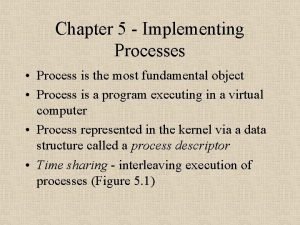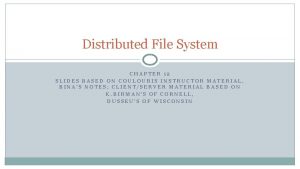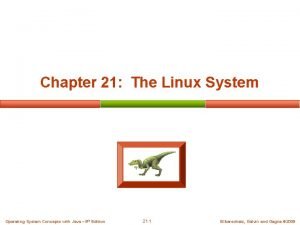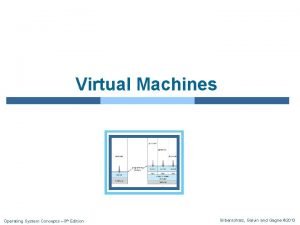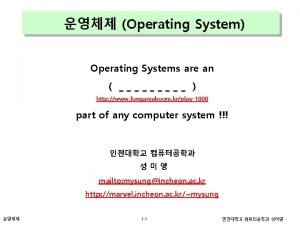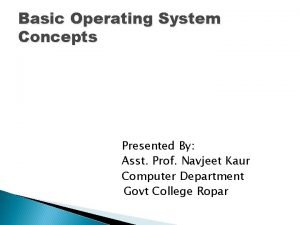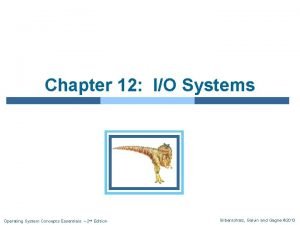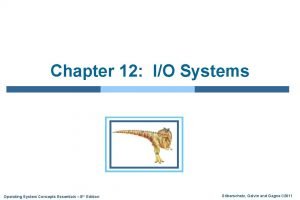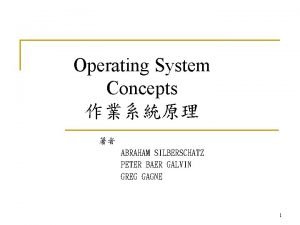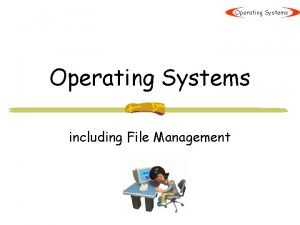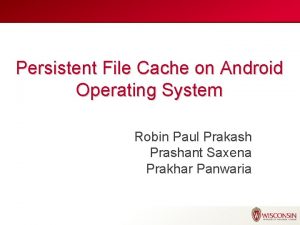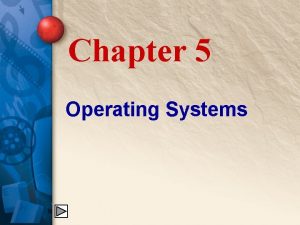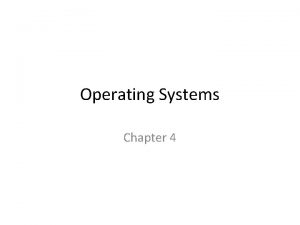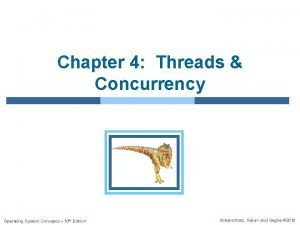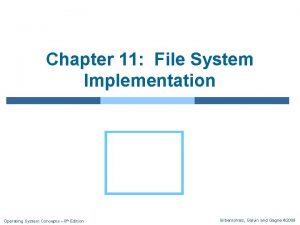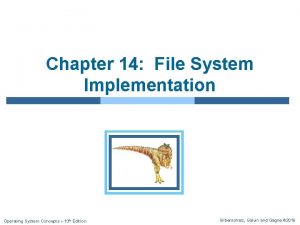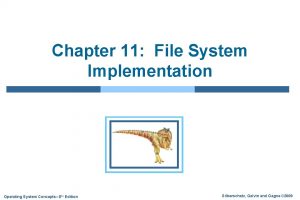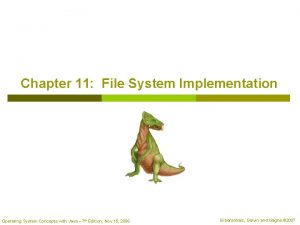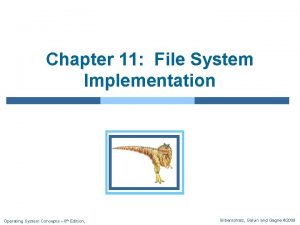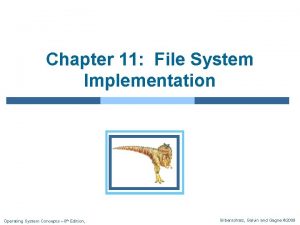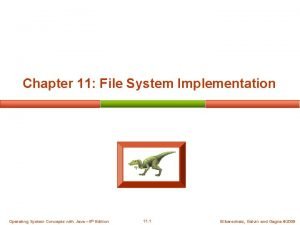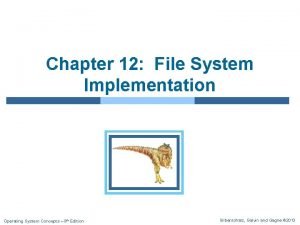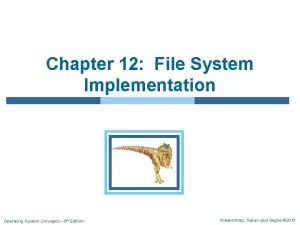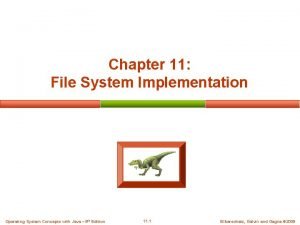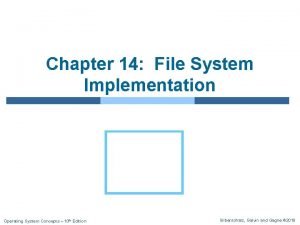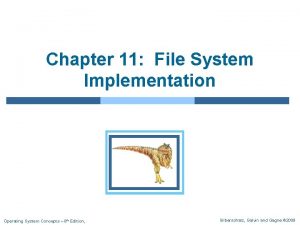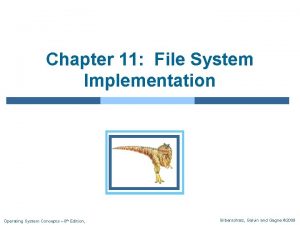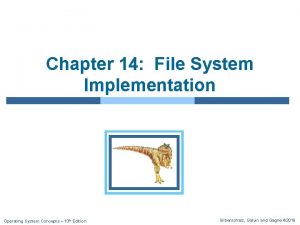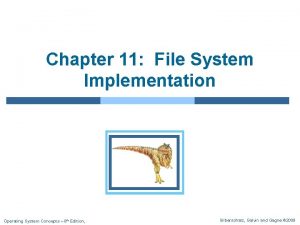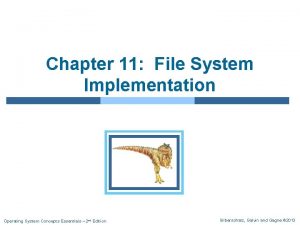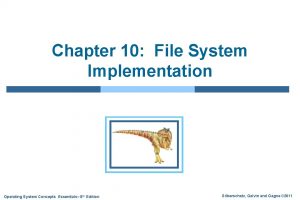Chapter 11 File System Implementation Operating System Concepts


























![Free-Space Management Bit vector (n blocks) 0 1 2 n-1 … bit[i] = 0 Free-Space Management Bit vector (n blocks) 0 1 2 n-1 … bit[i] = 0](https://slidetodoc.com/presentation_image_h2/b2576a5895feb83d679acc496e6c5961/image-27.jpg)








- Slides: 35

Chapter 11: File System Implementation Operating System Concepts – 8 th Edition, Silberschatz, Galvin and Gagne © 2009

Chapter 11: File System Implementation n File System Structure n File System Implementation n Directory Implementation n Allocation Methods n Free-Space Management n Efficiency and Performance n Recovery n Log-Structured File Systems Operating System Concepts – 8 th Edition Silberschatz, Galvin and Gagne © 2009

File-System Structure n File structure l Logical storage unit l Collection of related information n File system resides on secondary storage (disks) n File system organized into layers n File control block – storage structure consisting of information about a file Operating System Concepts – 8 th Edition Silberschatz, Galvin and Gagne © 2009

Layered File System Operating System Concepts – 8 th Edition Silberschatz, Galvin and Gagne © 2009

Layered File System Summary n I/O control – device drivers & interrupt handlers n Basic File System – issues command to device driver to read/write physical blocks (uses numeric disk address: drive 1, cyl 73, track 2, sector 10) n File-Organization Module – translates logical block address to physical block address, manages free-space n Logical File System – Manages the “metadata” – information relating to the file-system structure via FCBs Operating System Concepts – 8 th Edition Silberschatz, Galvin and Gagne © 2009

Overview n On- Disk structures l Boot control block – information needed to boot the system l Partition control block – contains partition details – number of blocks in partition, size of block, free- block data l Directory structure – contains data about organization of files l FCBs – actual file data n In-Memory structures l Partition table – information about mounted partitions l Directory structure – recently accessed directories l System-wide open-file table – FCB of open file l Per-process open-file table – pointer to system-wide openfile table’s entry … (index is returned from open( )) Operating System Concepts – 8 th Edition Silberschatz, Galvin and Gagne © 2009

A Typical File Control Block Operating System Concepts – 8 th Edition Silberschatz, Galvin and Gagne © 2009

In-Memory File System Structures n The following figure illustrates the necessary file system structures provided by the operating systems. n Figure 12 -3(a) refers to opening a file. n Figure 12 -3(b) refers to reading a file. Operating System Concepts – 8 th Edition Silberschatz, Galvin and Gagne © 2009

In-Memory File System Structures Operating System Concepts – 8 th Edition Silberschatz, Galvin and Gagne © 2009

Directory Entry Operating System Concepts – 8 th Edition Silberschatz, Galvin and Gagne © 2009

Example of a File lookup Operating System Concepts – 8 th Edition Silberschatz, Galvin and Gagne © 2009

Directory Implementation n Linear list of file names with pointer to the data blocks. l simple to program l time-consuming to execute n Hash Table – linear list with hash data structure. l decreases directory search time l collisions – situations where two file names hash to the same location l fixed size – difficult to change size of directory- must change hash function and reorganize all entries Operating System Concepts – 8 th Edition Silberschatz, Galvin and Gagne © 2009

Allocation Methods An allocation method refers to how disk blocks are allocated for files: n Contiguous allocation n Linked allocation n Indexed allocation Operating System Concepts – 8 th Edition Silberschatz, Galvin and Gagne © 2009

Contiguous Allocation n Each file occupies a set of contiguous blocks on the disk. Advantages n Simple – only starting location (block #) and length (number of blocks) are required. n Entire file can be read from disk in one operation n Random access. Disadvantages n Need to know maximum size at creation n Extreme fragmentation until reaches fullsize n Files cannot grow – size may be underestimated n Placement strategies – first fit/best fit Operating System Concepts – 8 th Edition Silberschatz, Galvin and Gagne © 2009

Contiguous Allocation of Disk Space Operating System Concepts – 8 th Edition Silberschatz, Galvin and Gagne © 2009

Extent-Based Systems n Many newer file systems (I. e. Veritas File System) use a modified contiguous allocation scheme. n Extent-based file systems allocate disk blocks in extents. n An extent is a contiguous block of disks. Extents are allocated for file allocation. A file consists of one or more extents. Operating System Concepts – 8 th Edition Silberschatz, Galvin and Gagne © 2009

Linked Allocation n Each file is a linked list of disk blocks: blocks may be scattered anywhere on the disk. block Operating System Concepts – 8 th Edition = pointer Silberschatz, Galvin and Gagne © 2009

Linked Allocation (Cont. ) Advantages n Simple – need only starting address n Free-space management system – no waste of space n Fragmentation only in last block Disadvantages n No random access n If one block goes bad – lose entire file n Pointer is substantial overhead Alternative: collect blocks into clusters and allocate clusters – pointers use much smaller percentage of disk space Operating System Concepts – 8 th Edition Silberschatz, Galvin and Gagne © 2009

Linked Allocation Operating System Concepts – 8 th Edition Silberschatz, Galvin and Gagne © 2009

Linked using Index n Remove pointer from data block and store pointer in a table Advantages n Speed up random access n Lookup can be done in memory Disadvantages n Tables needs to be in memory n Small blocks create large tables Example: File Allocation Table – Index set aside at start of disk partition. Indexed by physical blocks (0 indicates free block). Operating System Concepts – 8 th Edition Silberschatz, Galvin and Gagne © 2009

File-Allocation Table Operating System Concepts – 8 th Edition Silberschatz, Galvin and Gagne © 2009

Indexed Allocation n Brings all pointers together into the index block. The ith index indicates physical address of ith block n Logical view. index table Operating System Concepts – 8 th Edition Silberschatz, Galvin and Gagne © 2009

Example of Indexed Allocation Operating System Concepts – 8 th Edition Silberschatz, Galvin and Gagne © 2009

Indexed Allocation (Cont. ) Advantages n Random access is simple and fast n Files can grow – add entry to index Disadvantages n Index table has fragmentation n Random access How large should the index block be? How should we index large files? n Linked scheme – link several indexes together n Multilevel index – use first level to point to next level n Combine – UNIX inode scheme Operating System Concepts – 8 th Edition Silberschatz, Galvin and Gagne © 2009

Indexed Allocation – Multilevel outer-index table Operating System Concepts – 8 th Edition file Silberschatz, Galvin and Gagne © 2009

Combined Scheme: UNIX Operating System Concepts – 8 th Edition Silberschatz, Galvin and Gagne © 2009
![FreeSpace Management Bit vector n blocks 0 1 2 n1 biti 0 Free-Space Management Bit vector (n blocks) 0 1 2 n-1 … bit[i] = 0](https://slidetodoc.com/presentation_image_h2/b2576a5895feb83d679acc496e6c5961/image-27.jpg)
Free-Space Management Bit vector (n blocks) 0 1 2 n-1 … bit[i] = 0 block[i] free 1 block[i] occupied Block number calculation (number of bits per word) * (number of 0 -value words) + offset of first 1 bit Operating System Concepts – 8 th Edition Silberschatz, Galvin and Gagne © 2009

Free-Space Management (Cont. ) n Bit map requires extra space. Example: block size = 212 bytes disk size = 230 bytes (1 gigabyte) n = 230/212 = 218 bits (or 32 K bytes) n Easy to get contiguous files Operating System Concepts – 8 th Edition Silberschatz, Galvin and Gagne © 2009

Free-Space Management (Cont. ) Linked list (free list) - free list head pointer points to first free block. l Cannot get contiguous space easily l No waste of space – only one pointer to keep in memory Allocation – remove block on front of list, change head pointer to next block Adding free block – add to front of list Operating System Concepts – 8 th Edition Silberschatz, Galvin and Gagne © 2009

Linked Free Space List on Disk Operating System Concepts – 8 th Edition Silberschatz, Galvin and Gagne © 2009

Free-Space Management (Cont. ) Grouping – Use first free block to store the next n free block addresses. At end of this block point to n+1 block which contains the next n free blocks. Only one block needs to be stored in memory. l Allocation – delete first entry in first block l Adding to free list – add entry to first available spot in block (may need to go to next block) Counting – If blocks are allocated contiguously – store address of start block and number of free blocks in the same format as grouping Operating System Concepts – 8 th Edition Silberschatz, Galvin and Gagne © 2009

Free-Space Management (Cont. ) n Need to protect: l Pointer to free list l Bit map 4 Must be kept on disk 4 Copy in memory and disk may differ. 4 Cannot allow for block[i] to have a situation where bit[i] = 1 in memory and bit[i] = 0 on disk. l Solution: 4 Set bit[i] = 1 in disk. 4 Allocate 4 Set block[i] bit[i] = 1 in memory Operating System Concepts – 8 th Edition Silberschatz, Galvin and Gagne © 2009

Efficiency and Performance n Efficiency dependent on: l disk allocation and directory algorithms l types of data kept in file’s directory entry n Performance l disk cache – separate section of main memory for frequently used blocks l free-behind and read-ahead – techniques to optimize sequential access l improve PC performance by dedicating section of memory as virtual disk, or RAM disk. Operating System Concepts – 8 th Edition Silberschatz, Galvin and Gagne © 2009

Recovery n Consistency checking – compares data in directory structure with data blocks on disk, and tries to fix inconsistencies. n Use system programs to back up data from disk to another storage device (floppy disk, magnetic tape). n Recover lost file or disk by restoring data from backup. Operating System Concepts – 8 th Edition Silberschatz, Galvin and Gagne © 2009

End of Chapter 11 Operating System Concepts – 8 th Edition, Silberschatz, Galvin and Gagne © 2009
 File-file yang dibuat oleh user pada jenis file di linux
File-file yang dibuat oleh user pada jenis file di linux Operating system concepts chapter 8 solutions
Operating system concepts chapter 8 solutions Operating system concepts chapter 5 solutions
Operating system concepts chapter 5 solutions Operating system concepts chapter 5 solutions
Operating system concepts chapter 5 solutions File system in operating system
File system in operating system Ufs4.0
Ufs4.0 File system in operating system
File system in operating system Implementation of process in operating system
Implementation of process in operating system Distributed file system notes
Distributed file system notes Operating system concepts, 10th edition
Operating system concepts, 10th edition Linux operating system concepts
Linux operating system concepts Operating system concepts with java
Operating system concepts with java Operating system concepts 6th edition
Operating system concepts 6th edition Operating system concepts 9
Operating system concepts 9 Real time characteristics of embedded operating systems
Real time characteristics of embedded operating systems Ts 파일 일괄 다운로드
Ts 파일 일괄 다운로드 Basic operating system concepts
Basic operating system concepts Operating system concepts 11th
Operating system concepts 11th Operating system concepts essentials
Operating system concepts essentials Operating system concepts essentials
Operating system concepts essentials Operating system abraham silberschatz
Operating system abraham silberschatz File management in operating system pdf
File management in operating system pdf File management in android operating system
File management in android operating system Components of operating system
Components of operating system Distributed file system
Distributed file system In a file-oriented information system, a transaction file
In a file-oriented information system, a transaction file Operating systems concepts
Operating systems concepts Geography: realms, regions, and concepts (doc or html) file
Geography: realms, regions, and concepts (doc or html) file Module 4 operating systems and file management
Module 4 operating systems and file management Difference between logical file and physical file
Difference between logical file and physical file File sharing management system
File sharing management system An html file is a text file containing small markup tags
An html file is a text file containing small markup tags Types of nos
Types of nos Understanding operating system
Understanding operating system Chapter 4 operating system
Chapter 4 operating system Concurrency vs parallelism in os
Concurrency vs parallelism in os







